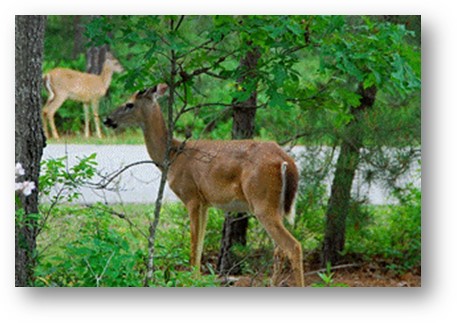
ENGELWOOD, N.J.—With deer population likely doubling every year or two, the city’s Deer Task Force director recommended Nov. 26 that council members conduct an aerial drone survey to get precise deer population numbers and also survey residents about deer-related impacts.
The council took no action on either recommendation.
Lisa Wisotsky, task force director, said more precise deer population numbers are needed by council members before any decisions can be made about possible deer-management options.
In addition, she said the task force needed to hear from residents to get better data on deer-related impacts, such as Lyme disease cases, and landscape and property damage.
Wisotsky noted between late November and March is best to conduct a drone survey, as leaves are off most trees and drone photos capture all deer present.
Deer drone survey: $4,500
She said of two price quotes solicited, the consultant who performed River Vale’s drone study earlier this year was lowest at about $4,500 for the survey.
River Vale is considering a possible deer bowhunt in 2020 to reduce deer numbers—determined to be 95 deer per square mile by drone survey.
However, the council has taken no action on the matter after facing regular public opposition at council meetings during spring and summer.
Only Saddle River, now conducting its second consecutive bowhunt, has undertaken a hunt in Bergen County to reduce deer population.
‘Needs objective data’
“We feel that the [Englewood City] council needs objective data to guide their decision-making process,” said Wisotsky, noting another study could be performed in a year or two to track and review city deer numbers.
She later noted that more “objective data” on deer numbers could help put pressure on Bergen County government to get more involved with countywide deer management measures.
Previously, task force members had conducted a “spotlight survey” of deer while driving around at dawn and dusk to count deer visible throughout the city’s four wards. Volunteers used flashlights to spot deer roaming about during early morning or late evening hours.
Wisotsky said initiating a drone survey would be much more accurate and offer valid data that could be used in advancing Englewood’s efforts to better manage deer numbers.
Previously, James Koth, Bergen County Director of Parks and Recreation, told Northern Valley Press that concluding its first-ever county Parks Master Plan (scheduled for Freeholder adoption in January) was necessary before undertaking a future effort to create a county wildlife management plan, which would likely address deer management options.
‘Improve public safety’
Wisotsky told council members that River Vale used drone survey results to “improve public safety” by installing road signage warning of possible deer crossing by areas where deer were found concentrated.
The task force held two public meetings—one last December and one in June—where presentations were made first to residents and then public officials by state wildlife officials.
In June, state wildlife officials and an animal-rights organization spoke, offering lethal and non-lethal methods to control and manage deer population.
State: Hunting recommended
Currently, state wildlife officials mostly recommend hunting, both bowhunt and firearm seasons, as effective methods to reduce deer population.
In Bergen County, local ordinances prohibiting firearm discharges as well as other lethal methods—including bowhunts—generally prohibit such hunts unless a new ordinance is adopted by a council to allow such methods.
Moreover, animal-rights organizations, such as Animal Protection League of New Jersey, oppose hunting in any form and have rallied at public meetings in Bergen County to oppose Saddle River’s hunt, River Vale’s proposed hunt, and hunting in general as an inhumane option.
Wisotsky noted that River Vale’s town administrator said its council was “shocked” by the high concentration of deer there.
Mayor Michael Wildes said he had issues with the drone and resident surveys, “if the end of this is to justify a hunt, I’m developing problems with that.”
He said a regional approach needs to be initiated to work on a regional solution, possibly starting with a regional deer drone survey if neighboring towns would join the effort.
And that may help put pressure on the county to get involved in deer control, Wildes said.
Survey ‘absolutely necessary’
Wisotsky defended the drone survey as “absolutely necessary” to know how many deer Englewood has.
“I think that Englewood has to be a leader and one thing that I gathered from the mayors’ symposiuim [in June] is that all the towns want to work together in a regional approach,” said Wisotsky.
“If you don’t have the data, it’s going to be really hard to move forward,” she said.
Wildes noted that a more regional approach with more towns participating would provide a sign to county officials to get involved due to widespread concern about deer population.
“We missed a lot of territory [with deer],” said Wisotsky of the city’s initial deer census taken in early 2019.
Deer-related impacts
Prior to Wisotsky’s presentation, city Health Director James Fedorko reported an increase in city deer-related emergency “service calls,” Lyme disease cases, and auto accidents between 2016 to 2018.
Fedorko referred to a task force report submitted to the council. Northern Valley Press submitted a public records request Nov. 27 for the report. The report was not made available at the meeting.
At the June forum sponsored by the city Deer Task Force, a top state Division of Fish and Wildlife official urged the towns to move forward with plans of their own rather than waiting for a regional plan to take shape.
Many mayors and officials then favored a regional approach involving all Northern Valley towns and sought involvement from Bergen County, with 9,000-plus acres of open space (golf courses and parks), and Suez North America, which owns thousands of acres of Bergen County watershed land.
Despite enthusiasm for another mayors’ forum on deer issues, no such meeting occurred.
